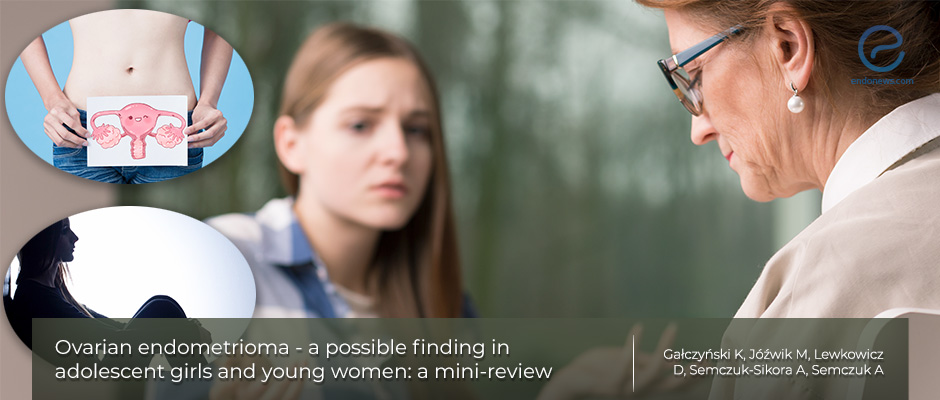A review of endometriosis in adolescent girls and young women
Feb 7, 2020
Endometriosis is a chronic inflammatory disease which can be diagnosed in adolescent girls and even young women with drug-resistant chronic pelvic pain or adnexal mass.
Key Points
Highlights:
- The diagnosis of endometriosis in adolescent women is delayed for 8-10 years since it is not considered in the differential diagnosis of pelvic pain or adnexal mass.
Importance:
- Endometriosis and/or endometrioma should be kept in mind and managed appropriately in adolescent women with drug-resistant chronic pelvic pain or adnexal mass.
What’s done here?
- This review was conducted to clarify that endometriosis may also be encountered in adolescent women and even in young girls.
- The etiopathogenetic mechanisms, diagnostic methods, treatment modalities and the association between endometriosis and cancer in this age group were also summarized.
Key results:
- Although there are many theories about the development of endometriosis, retrograde menstruation theory (Sampson’s theory) is the most accepted theory. According to this theory, the endometrial cells refluxed into the abdominal cavity attached to the peritoneum resulting in endometriotic lesions.
- The reason that retrograde menstruation occurs 90% of the time, but does not cause endometriosis often is attributed to the altered hormonal and immunological environment of women with endometriosis. The origin of early-onset endometriosis in adolescents is accepted as neonatal uterine bleeding which occurs in approximately 5% of female neonates.
- Endometriomas origin from inversion and progressive invagination of ovarian cortex with endometriotic implants or the metaplasia invaginated ovarian celomic epithelium.
- The most common presenting complaints are mainly chronic pelvic pain, dysmenorrhea and if sexually active, dyspareunia and infertility.
- It is demonstrated that diagnostic delay can be shortened if the adolescent women with pelvic pain consult to the obstetrician-gynecologists rather than other physicians.
- Ultrasonographic examination is the initial diagnostic imaging method for these adolescents consulted with pelvic pain. However, if more extensive pelvic exploration is necessary, further imaging modalities such as computed tomography or magnetic resonance imaging can be used.
- Affected women demand therapy for these symptoms of endometriosis, notably pelvic pain.
- Different management modalities are present including medical treatment, surgery, and combined approach.
- Although laparoscopy and histopathological examination of the excised endometriotic lesions is the gold standard for the definitive diagnosis, it is important to care about the detrimental effect of surgical approach on ovarian reserve and future fertility potential.
- There is also an association between endometriosis and the development of clear-cell carcinoma and endometrioid ovarian cancer.
Lay Summary
Endometriosis is an estrogen-dependent disease which is commonly diagnosed in reproductive-aged women. On the other hand, this disease can develop earlier in life due to different etiopathogenetic mechanisms. Especially adolescents who experienced neonatal uterine bleeding are under the risk for endometriosis. Gałczyński et al, a group of scientists from Poland, published a mini-review titled as “Ovarian endometrioma – a possible finding in adolescent girls and young women: a mini-review” in the journal named as Journal of Ovarian Research. They aimed to review the etiopathogenetic mechanisms, diagnostic methods, treatment modalities and the association between endometriosis and cancer in this age group. The most common complaints of endometriosis are pain (dysmenorrhea, dyspareunia, chronic pelvic pain) and fertility problems. Although advanced research on the etiology, differential diagnosis and treatment has been performed, it still remains as an enigmatic disease. The most commonly accepted theory which explains the development of endometriosis is retrograde menstruation theory. Ovarian endometriotic cysts named as endometriomas can be encountered in 17-44% of women with endometriosis. The development of endometriomas can be explained by inversion and progressive invagination of ovarian cortex with endometriotic implants or metaplasia invaginated ovarian celomic epithelium. Ultrasound is the initial test to diagnose endometriomas which is an easily accessible and widely available imaging method. Current medical and surgical treatment options have several limitations including the side effects, costs, risk of recurrence, effects on conception capability. Most available medical treatment options are non-steroidal anti-inflammatory drugs, oral contraceptives, progestins and gonadotropin releasing hormone agonists. Laparoscopy provides both definitive diagnosis and treatment for endometriosis. After laparoscopic evaluation of pelvis, endometriosis can also be staged to establish a common language between clinicians. The most commonly used classification system is the revised American Society for Reproductive Medicine (rASRM), which allows the categorization of endometriosis as mild, moderate or severe based on the localization, size of implants, ovarian endometriosis and extent of adhesions. However, the detrimental effect of surgical approach on ovarian reserve and future fertility potential should not be forgotten. It has been demonstrated that there is an association between endometriosis and clear-cell carcinoma and endometrioid ovarian cancer due to some genetic mutations and common developmental mechanisms.
“Endometriosis-like symptoms in girls before the age of 15 years or before menarche indicate the need to screen such girls as early as they develop prominent symptoms.” the authors added.
Research Source: https://www.ncbi.nlm.nih.gov/pubmed/31699129
endometriosis endometrioma ovarian cyst adolescence adolescents diagnosis neonatal uterine bleeding treatment

